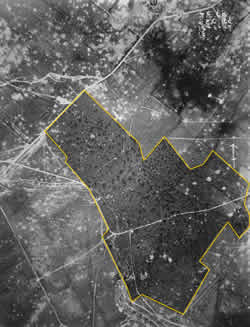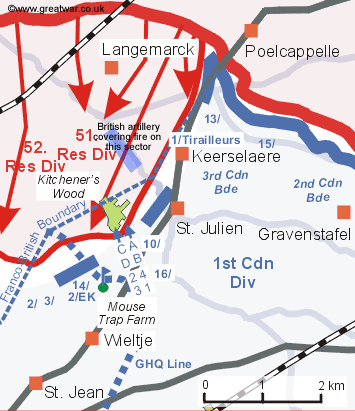 Canadian Battalions counter-attack at Kitchener's Wood
Canadian Battalions counter-attack at Kitchener's Wood
22 April 1915: 23.50
The 10th and 16th Battalions Assemble for the Attack
The 10th Battalion and 16th Battalion formed up for the counter-attack in the assembly positions. Kitchener's Wood was silhouetted in the dim light of the moon in a cloudy sky.

|
The War Diary of the 10th Canadian Battalion reported from 11.10pm to midnight :
“The 10th CAN. BN. was in position awaiting the 16th part of which we passed on our way to take up our position. There was sufficient light to see what we had to do. The woods C.10.d and C.11.c. [trench map reference for Kitchener's Wood] loomed up to our front about 500 to 600 yards. we [sic] also saw the house C.16.b [trench map reference believed to refer to Oblong Farm] and a consultation was held about sending a party to clear it as we were satisfied that this house would contain machine guns (which it did) but on re-reading the order it was decided that this was not our job and would be attended by someone else.” (1)
At 11.45pm the 16th Battalion reported that it was in position and ready to make the attack.
Companies Form Up into Position
The map below shows the company forming-up positions for each battalion.
At 10.47pm the War Diary of the 10th Battalion reported:
“The … order was issued by GEN. TURNER and signed by BDE MAJ., LT. COL. G. B. HUGHES [the Brigade Major of 3rd Brigade]. CAPT MACDONALD [the Staff Captain of 3rd Brigade headquarters] then guided us to our position for the attack ordered, we lined up in columns of half BN. [half a Battalion, this being two companies] A Co [sic: "A" Coy] on the right "C" Coy on the left forming the front two lines, fyles [sic] being 30 yards distance. "B" Coy on the right and "D" Coy on the left formed the 3rd and 4th lines, we were supported by the 16th CAN. INF. BN. [16th Canadian Infantry Battalion]” (2)

Regarding the 16th Battalion's preparation for the counter-attack Major McLaren wrote in the War Diary of the 16th Battalion:
“On arrival at Brigade Head Quarters [Mouse Trap Farm] informed that my task was to support closely the 10th Battalion which had already arrived and attack the enemy at 10.30 p.m. so as to clear the wood N. West of St. Julien. Attack delayed until 11.30.
Formed up in the moonlight about 1000 yds from the enemy and close to St Julien road. Formation adopted: 10th Batt. in front on two company width double rank, thus forming 2 lines 30 yds apart. 16th Battalion formed up in 4 lines single rank 30 yds behind 10th Battalion and lines 30 yds apart.
No 4 Co. on right and No 2 on left of front line. No 1 and 3 in rear of 4 and 2 respectively.” (3)
In total there were eight waves to make the counter-attack. The attacking waves were in a depth of 165 metres on a two company frontage with distances of 27 metres (30 yards) between the lines. The attack was to be accompanied by 30 bombers of the 2nd Canadian Infantry Brigade and 70 bombers from the 3rd Infantry Brigade.(4)
Order to Advance
The Brigade Major (of 3rd Canadian Infantry Brigade), Lieutenant-Colonel G B Hughes, was in the assembly position. On receiving this information he gave direction on the Pole Star and gave the order to advance.
The men began the attack in silence. The War Diary of the 10th Canadian Battalion described the silent movement of the men as they set off towards the wood:
“...the order to advance given, not a sound was audible down the long waiving lines but the soft pad of feet and the knock of bayonet scabbard against thighs.” (5)
Next>> French troops move from the Army reserve
Acknowledgements
(1) War Diary of 10th Canadian Battalion, April 1915: ref. WO 95/3770
(2) War Diary of 10th Canadian Battalion, April 1915: ref. WO 95/3770
(3) War Diary of the 16th Canadian Battalion, April 1915
(4) War Diary of the 3rd Canadian Infantry Brigade, April 1915: Diary of Operations 22nd April to 5th May, 1915
(5) War Diary of 10th Canadian Battalion, April 1915: ref. WO 95/3770